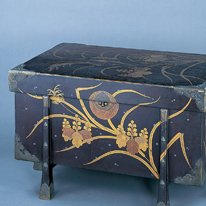Past Exhibitions
- Kōdai-ji Makie Lacquer: Gems of Momoyama Culture
- October 21, 2014 - November 24, 2014
In the sixteenth century, the warlords who emerged out of the long era of civil war began competing amongst themselves again, this time in the construction of temples and castles. They decorated the interiors of these structures with golden paintings and lacquered surfaces embellished with makie-pictorial decoration made with sprinkled metallic powder. Soon gold makie became popular for a range of furnishings, even daily tablewares, and the demand these lacquers escalated rapidly. One way in which this new demand was fulfilled was with a type of lacquer now called Kōdai-ji makie, which incorporated clean designs and simple techniques. This lacquer style typically features a black lacquer background with sprinkled gold designs in flat hiramakie, enashiji (design areas filled with the sprinkled "pear skin" pattern usually reserved for backgrounds), harigaki (finely incised lines), and other techniques that bring out the contrast between the black lacquer and the gold. The name "Kōdai-ji makie" refers to the temple of Kōdai-ji in Kyoto, which was built as a posthumous memorial to Hideyoshi by his wife and houses many lacquer objects using this technique.













